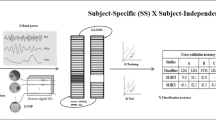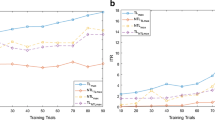Abstract
A major factor blocking the practical application of brain-computer interfaces (BCI) is the long calibration time. To obtain enough training trials, participants must spend a long time in the calibration stage. In this paper, we propose a new framework to reduce the calibration time through knowledge transferred from the electroencephalogram (EEG) of other subjects. We trained the motor recognition model for the target subject using both the target’s EEG signal and the EEG signals of other subjects. To reduce the individual variation of different datasets, we proposed two data mapping methods. These two methods separately diminished the variation caused by dissimilarities in the brain activation region and the strength of the brain activation in different subjects. After these data mapping stages, we adopted an ensemble method to aggregate the EEG signals from all subjects into a final model. We compared our method with other methods that reduce the calibration time. The results showed that our method achieves a satisfactory recognition accuracy using very few training trials (32 samples). Compared with existing methods using few training trials, our method achieved much greater accuracy.

The framework of the proposed method. The workflow of the framework have three steps: 1, process each subjects EEG signals according to the target subject’s EEG signal. 2, generate models from each subjects’ processed signals. 3, ensemble these models to a final model, the final model is a model for the target subject.





Similar content being viewed by others
References
Millán JDR, Rupp R, Müllerputz GR, Murraysmith R, Giugliemma C, Tangermann M et al (2010) Combining brain–computer interfaces and assistive technologies: state-of-the-art and challenges. Front Neurosci 4(5):161
Wilson JA, Felton EA, Garell PC, Schalk G, Williams JC (2006) Ecog factors underlying multimodal control of a brain-computer interface. IEEE Trans Neural Syst Rehabil Eng 14(2):246–250
Song J, Young BM, Nigogosyan Z, Walton LM, Nair VA, Grogan SW et al (2014) Characterizing relationships of dti, fmri, and motor recovery in stroke rehabilitation utilizing brain-computer interface technology. Frontiers in Neuroengineering 7:31
Coyle S, Ward T, Markham C, Mcdarby G (2004) On the suitability of near-infrared (nir) systems for next-generation brain-computer interfaces. Physiol Meas 25(4):815–822
Zhang R, Li Y, Yan Y, Zhang H, Wu S, Yu T, Gu Z (2016) Control of a wheelchair in an indoor environment based on a brain–computer interface and automated navigation. IEEE Transactions on Neural Systems & Rehabilitation Engineering A Publication of the IEEE Engineering in Medicine & Biology Society 24(1):128–139
Bhattacharyya S, Konar A, Tibarewala DN (2014) Motor imagery, p300 and error-related eeg-based robot arm movement control for rehabilitation purpose. Med Biol Eng Comput 52(12):1007–1017
Savić AM, Popović MB. (2016) Brain computer interface prototypes for upper limb rehabilitation: a review of principles and experimental results. Telecommunications forum Telfor (pp.452-459). IEEE
Corralejo R, Nicolás-Alonso LF, Alvarez D, Hornero R (2014) A p300-based brain-computer interface aimed at operating electronic devices at home for severely disabled people. Med Biol Eng Comput 52(10):861–872
Wang YK, Jung TP, Lin CT (2015) Eeg-based attention tracking during distracted driving. IEEE Trans Neural Syst Rehabil Eng 23(6):1085–1094
Horki P, Solis-Escalante T, Neuper C, Müller-Putz G (2011) Combined motor imagery and ssvep based bci control of a 2 dof artificial upper limb. Med Biol Eng Comput 49(5):567–577
Punsawad Y, Wongsawat Y (2017) A multi-command ssvep-based bci system based on single flickering frequency half-field steady-state visual stimulation. Med Biol Eng Comput 55(6):965–977
Golub MD, Chase SM, Batista AP, Yu BM (2016) Brain-computer interfaces for dissecting cognitive processes underlying sensorimotor control. Curr Opin Neurobiol 37:53–58
Lotte F (2015) Signal processing approaches to minimize or suppress calibration time in oscillatory activity-based brain–computer interfaces. Proc IEEE 103(6):871–890
Tu W, Sun S (2013) Semi-supervised feature extraction for eeg classification. Pattern Anal Applic 16(2):213–222
Meng J, Sheng X, Zhang D, Zhu X (2014) Improved semisupervised adaptation for a small training dataset in the brain-computer interface. IEEE J Biomed Health Inform 18(4):1461–1472
Chen M, Tan X, Zhang L (2016) An iterative self-training support vector machine algorithm in brain-computer interfaces. Intelligent Data Analysis 20(1):67–82
Lotte F (2011) Generating artificial eeg signals to reduce bci calibration time. 5th international brain-computer Interface workshop, Graz, p 176–179
Jayaram V, Alamgir M, Altun Y, Scholkopf B (2015) Transfer learning in brain-computer interfaces. IEEE Comput Intell Mag 11(1):20–31
Dalhoumi S, Dray G, Montmain J (2014) Knowledge transfer for reducing calibration time in brain-computer interfacing. IEEE, international conference on TOOLS with artificial intelligence. IEEE, Limassol, p 634–639
Lotte F, Guan C (2011) Regularizing common spatial patterns to improve bci designs: unified theory and new algorithms. IEEE Trans Biomed Eng 58(2):355–362
Lu H, Eng HL, Guan C, Plataniotis KN, Venetsanopoulos AN (2010) Regularized common spatial pattern with aggregation for eeg classification in small-sample setting. IEEE Trans Biomed Eng 57(12):2936–2946
Lotte F, Guan C (2010) Learning from other subjects helps reducing brain-computer Interface calibration time. IEEE International Conference on Acoustics Speech and Signal Processing, vol 23. IEEE, Arras, p 614–617
Kang H, Nam Y, Choi S (2009) Composite common spatial pattern for subject-to-subject transfer. IEEE Signal Process Lett 16(8):683–686
Barachant A, Bonnet S, Congedo M, Jutten C (2012) Multiclass brain-computer interface classification by riemannian geometry. IEEE Trans Biomed Eng 59(4):920–928
Tu W, Sun S (2012) A subject transfer framework for EEG classification. Neurocomputing 82:109–116
Fazli S, Popescu F, Danóczy M, Blankertz B, Müller KR, Grozea C (2009) Subject-independent mental state classification in single trials. Neural Netw 22(9):1305–1312
Tu W, Sun S (2012) Dynamical ensemble learning with model-friendly classifiers for domain adaptation. International Conference on Pattern Recognition (pp.1181-1184). IEEE
Pfurtscheller G, Fh LDS (1999) Event-related eeg/meg synchronization and desynchronization: basic principles. Clin Neurophysiol 110(11):1842–1857
Kai KA, Zheng YC, Wang C, Guan C, Zhang H (2012) Filter bank common spatial pattern algorithm on bci competition iv datasets 2a and 2b. Front Neurosci 6:39
Gouypailler C, Congedo M, Brunner C, Jutten C, Pfurtscheller G (2010) Nonstationary brain source separation for multiclass motor imagery. IEEE Trans Biomed Eng 57(2):469–478
Wang H (2011) Multiclass filters by a weighted pairwise criterion for eeg single-trial classification. IEEE Trans Biomed Eng 58(5):1412–1420
Asensiocubero J, Gan JQ, Palaniappan R (2013) Multiresolution analysis over simple graphs for brain computer interfaces. J Neural Eng 10(4):046014
Funding
This work was supported in part by National High Technology Research and Development Program of China (863 Program) under Grant 2015AA042301 and the National Natural Science Foundation of China under Grant 61773369, 61573340, 61503374.
Author information
Authors and Affiliations
Corresponding author
Appendix
Appendix
-
1.
Proof of \( {W}_2^{\hbox{'}}={W}_2{T}^T \)
The process of solving \( {W}_2^{\hbox{'}} \) is a parallelism of the CSP algorithm.
-
(1)
Find the covariance of the two types of motion:
-
(1)
where n = 1, 2.
-
(2)
Find the whitening matrix Q'.
-
(3)
Calculate the whitened matrix.
Then, S' and S' have the same eigenvector matrixU.
-
(4)
CalculateW′.
-
2.
Solution of the optimization:
In this part, we give the details of how to solve the optimization problem in section II.A. The problem is:
To easily and effectively make the calculation, the optimization problem with regular terms was transformed to an optimization formula without the regular terms. The Lagrangian multiplier method was used.
-
(1)
First, the target function is transformed.
\( {\left\Vert {W}_2-{W}_1\times {T}^T\right\Vert}_F^2= tr\left({W_1}^T{W}_1+{W_2}^T{W}_2\right)-2\times tr\left(T{W_1}^T{W}_2\right){\left\Vert T-P\right\Vert}_F^2= tr\left({\left(T-P\right)}^T\left(T-P\right)\right)= tr\left({T}^TT-{T}^TP-{P}^TT+{P}^TP\right) \)The constraint condition is TTT = I. Then,
\( {\left\Vert T-P\right\Vert}_F^2= tr\left(I-{T}^TP-{P}^TT+{P}^TP\right) \)We used trace to describe the orthogonality constraints. The Lagrange function is presented as follows.
L = − tr(TA) + αtr(−TTP − PTT + I + PTP) + λtr((QTQ − I)T(QTQ − I)) where \( A={W}_1^T{W}_2 \).
-
(2)
The minimization condition is
For the case,
Then,
where, B = (AT + 2αP)T = A + 2αPT
-
(3)
For optimization problems without the regular terms α and P, \( \mathrm{T}=\mathrm{argmin}\left({\left\Vert {\mathrm{W}}_2-{\mathrm{W}}_1\times {\mathrm{T}}^{\mathrm{T}}\right\Vert}_{\mathrm{F}}^2\right),\mathrm{st}.{\mathrm{T}}^{\mathrm{T}}\mathrm{T}=\mathrm{I} \), we have a similar transformation with the previous derivation.
The minimization condition is
-
(4)
By comparing the formulas in (2) and (3), the optimization problem of the regular term can be transformed into the optimization problem without the regular term.
where B = A + 2αPT.
Then, the new problem is solved as follows.
-
(1)
The matrix B is decomposed by the SVD method.
B = UΣVT, tr(TB) = tr(TUΣVT) = tr(VTTUΣ).
Let Z = VTTU Z = VTTU,
then Z is an orthogonal matrix with the condition
|zij| ≤ 1, ∀ i, j.
-
(2)
Then,
when Z = I, the equation is satisfied.
Hence, VTTU = I, T = VUT.
-
(3)
The final spatial filter is T = VUTT = VUT, where V, U is the result of the SVD decomposition on B.
Rights and permissions
About this article
Cite this article
Zou, Y., Zhao, X., Chu, Y. et al. An inter-subject model to reduce the calibration time for motion imagination-based brain-computer interface. Med Biol Eng Comput 57, 939–952 (2019). https://doi.org/10.1007/s11517-018-1917-x
Received:
Accepted:
Published:
Issue Date:
DOI: https://doi.org/10.1007/s11517-018-1917-x




